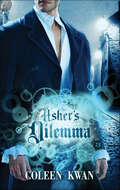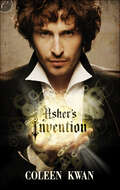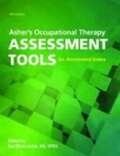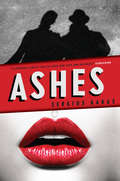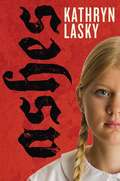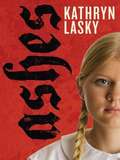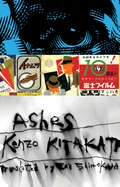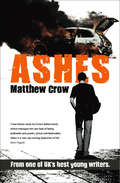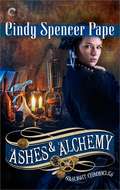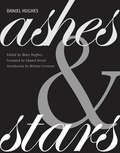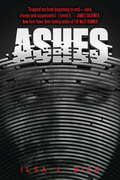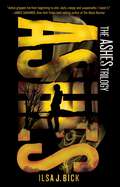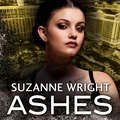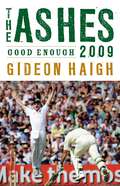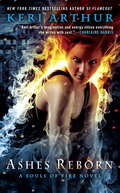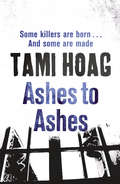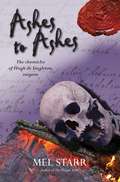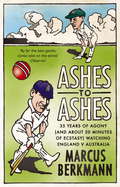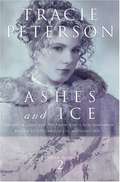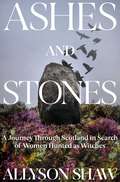- Table View
- List View
Asher's Dilemma
by Coleen KwanEver since he awoke one day on the floor of his workshop with a brain-splitting headache, Asher Quigley has been haunted by fleeting visions of a beautiful woman everywhere he looks-a woman he's sure he knows, but can't recall. In spite of this he has finished his most wondrous invention yet, one that will literally make history: a time machine. But before he can complete his exacting calculations a bizarre accident causes the device to be activated, with him inside! He awakes to find himself in his lab, eight months in the past, and suddenly he remembers her...Asher knows that something in the near future causes Minerva Lambkin, the woman who turned down his marriage proposal, to be erased from existence. And he's sure it has something to do with his device. Alone in a familiar world where he doesn't belong, he'll have to find a way to destroy the time machine to save the woman he loves from extinction. Even if that means erasing his own future.33,000 words
Asher's Invention
by Coleen KwanFive years ago, Asher Quigley broke his engagement to Minerva Lambkin, believing she was an accomplice in a scheme to steal his prototype for a wondrous device. Minerva swore she was innocent, though the thief-and Asher's mentor-was her own father.Now, sheer desperation has driven Minerva to Asher's door. Her father has been kidnapped by investors furious that he's never been able to make the machine work. Only Asher, now a rich and famous inventor in his own right, can replicate the device. He's also become a hard, distant stranger far different from the young idealist she once loved.Despite their troubled past, Asher agrees to help Minerva. He still harbors his suspicions about her, but their reunion stirs emotions and desires they both thought were buried forever. Can they rebuild their fragile relationship in time to save her father and their future together?29,000 words
Asher's Occupational Therapy Assessment Tools: An Annotated Index
by Ina Elfant AsherNearly 600 instruments are reviewed in this new edition of occupational therapy’s classic publication, including many developed by occupational therapists. An international team of academicians, clinicians, researchers, and advanced-degree candidates working in various practice arenas collaborated on this update. The assessment profiles―which include title, authors, format, purpose, population, time required to administer, setting or position, materials or tools, brief description, interpretation, reliability and validity, source, additional references, cost, and sample―will be useful to clinicians and students, who must choose appropriate tools for clinical practice; to educators, who select assessment procedures for the classroom; and to researchers, who will find instruments that are designed for research purposes or will benefit from further investigation. This edition includes a matrix of all assessments, showing content areas and age ranges of each instrument.
Ashes
by Anne-Marie Stanton-Ife Sergios GakasCalled "A gripping, gritty tale of love and loss and revenge (Eurocrime) and hailed as "a wonderful slice of Greek Noir," (Crimepieces) Ashes is classic noir set in a corrupt and crumbling society where addiction and regret are the only human qualities left. When Sonia Verika, a former actress who takes solace in alcohol and isolation, is pulled from a blazing house fire, her body is burned almost beyond recognition. The house she shared with a retired director and a small family of African refugees is entirely destroyed, and she is the only survivor. For her ex-lovers, Police Inspector Chronis Halkidis and Simeon Piertzovanis, a failed lawyer and the landlord of the gutted property, her fate is a heavy reckoning. Reflection gives way to guilt, and then to a fanatical desire to uncover the truth behind the blaze and hold those responsible to account--by any means necessary. But with corruption rife throughout the force, Chronis soon finds his investigation shackled from within. Fuelled by their need for revenge, and by their twin addictions to alcohol and cocaine, Simeon and Chronis must resort increasingly to violence if they are to unmask a conspiracy that unites church and state against the interests of justice. From the Hardcover edition.
Ashes
by Kathryn LaskyBerlin, 1932: In many ways thirteen-year-old Gabriella Schramm lives a charmed, carefree life. She loves her parents and her sister, Ulla. She loves her new literature teacher. She loves her family's summer lake house, next door to Albert Einstein's. And most of all, Gaby loves books. But soon she begins losing all these things, one by one, as Hitler unstoppably climbs to power. People Gaby thought she could trust turn out to be Nazis. Many of her friends are fleeing, or, worse, being taken away. And there's something troubling about Ulla's boyfriend that Gaby can't quite figure out. As always, she turns to her books for comfort--but even those are disappearing. Newbery Honor winner and master of historical fiction Kathryn Lasky once again brings the past to life with this searing portrait of a nation on the brink of war, and a girl whose life is about to change.
Ashes
by Kathryn LaskyBerlin, 1932. Thirteen-year-old Gabriella Schramm's world is slowly, but steadily, crumbling as Adolf Hitler rises to power. <P><P>The only thing that soothes Gabriella is her favorite pastime-reading. <P><P>But then her country's tensions rise, the streets fill with soldiers, Gaby's sister's boyfriend raises his arm in a heil Hitler salute, and a family friend-Albert Einstein-flees the country. <P><P>And her only solace-her books-come under attack. Will Gaby have to leave behind the stories-and the life-that she has always loved?
Ashes
by Kenzo KitakataThe vice and virtues of middle age are espied with an eagle eye in this hardboiled story about a mid-career gangster. Unfolding through chiseled sketches and run through with tantalizing motifs, Kitakata's masterpiece follows the fortunes of a yakuza mobster as his moment of truth approaches. Cool, real, and cleansing, Ashes is a literary tonic.
Ashes
by Matthew Crow&“Authentic and poetic, lyrical and believable . . . a raw, rip-roaring depiction of life&” from the author of In Bloom and Another Place (Mark Piggott, author of the Forever Avalon series). A lawless land of violence and deprivation, The Meadow Well Estate is a no-go area for police and non-residents alike and a hotbed of ritual violence. No one dares enter of their own accord, and few make it out alive. But Jack was one of the good ones. Recently released from prison, he is determined to turn his life completely around: by getting out. When, however, rumors spark of the police&’s involvement in the death of two young joy riders, the anxieties of the estate flare into a week-long riot, causing burnt out wrecks at every turn and capturing the attention of the local and national media. Can Jack resist the call of the indiscriminate fury, or will the desperation of Meadow Well claim him once more? Praise for Matthew Crow&’s In Bloom &“The Fault in Our Stars meets Adrian Mole. Moving, funny and brilliantly narrated.&”—Metro &“Wow. Read In Bloom right now. It will improve your life.&”—Matt Haig, international bestselling author &“A moving and wonderfully witty tale . . . This excellent book is worth anyone&’s time.&”—Daily Telegraph
Ashes
by Sergios GakasWhen Sonia Verika, a former actress who takes solace in alcohol and isolation, is pulled from the fire, her body is burned almost beyond recognition. The house she shared with a retired director and a small family of African refugees is entirely destroyed, and she is the only survivor. For her ex-lovers, Police Inspector Chronis Halkidis and Simeon Piertzovanis, a failed lawyer and the landlord of the gutted property, her fate is a heavy reckoning. Reflection gives way to guilt, and then to a fanatical desire to uncover the truth behind the blaze and hold those responsible to account - by any means necessary. But with corruption rife throughout the force, Chronis soon finds his investigation shackled from within. Fuelled by their need for revenge, and by their twin addictions to alcohol and cocaine, Simeon and Chronis must resort increasingly to violence if they are to unmask a conspiracy that unites church and state against the interests of justice. A classic noir thriller, Ashes is unflinching in its examination of the violence and extortion bred by corruption, but at the same time tender in its treatment of human weaknesses, of guilt, addiction and regret.
Ashes
by Sergios GakasWhen Sonia Verika, a former actress who takes solace in alcohol and isolation, is pulled from the fire, her body is burned almost beyond recognition. The house she shared with a retired director and a small family of African refugees is entirely destroyed, and she is the only survivor. For her ex-lovers, Police Inspector Chronis Halkidis and Simeon Piertzovanis, a failed lawyer and the landlord of the gutted property, her fate is a heavy reckoning. Reflection gives way to guilt, and then to a fanatical desire to uncover the truth behind the blaze and hold those responsible to account - by any means necessary. But with corruption rife throughout the force, Chronis soon finds his investigation shackled from within. Fuelled by their need for revenge, and by their twin addictions to alcohol and cocaine, Simeon and Chronis must resort increasingly to violence if they are to unmask a conspiracy that unites church and state against the interests of justice. A classic noir thriller, Ashes is unflinching in its examination of the violence and extortion bred by corruption, but at the same time tender in its treatment of human weaknesses, of guilt, addiction and regret.
Ashes & Alchemy
by Cindy Spencer PapeA Gaslight Chronicles novella: London, 1860 -- Police inspector Sebastian Brown served Queen and country in India before returning to England to investigate supernatural crimes alongside the Order of the Round Table. If his wifeless, childless life feels a little empty sometimes, that's not too great a price to pay in the name of duty.Minerva Shaw is desperately seeking a doctor when she mistakenly lands on Sebastian's doorstep. Her daughter Ivy has fallen gravely ill with a mysterious illness-the same illness, it seems, that's responsible for taking the lives of many of Ivy's classmates.Seb sniffs a case, and taking in Minnie and Ivy seems the only way to protect them while he solves it. But as mother and daughter work their way into his heart and Seb uses every magickal and technological resource he can muster to uncover the source of the deadly plague, it's he who will need protecting-from emotions he'd thought buried long ago.
Ashes & Stars
by Edward Hirsch Daniel Hughes Mary Hughes Michael ScrivenerFifty-five of Daniel Hughes's final poems, containing distinctly insightful and literate meditations on themes of love, art, and hope.
Ashes (Ashes Triology #1)
by Ilsa J. BickAlex has run away and is hiking through the wilderness with her dead parents' ashes, about to say goodbye to the life she no longer wants to live. But then the world suddenly changes. An electromagnetic pulse sweeps through the sky zapping every electronic device and killing the vast majority of adults. For those spared, it's a question of who can be trusted and who has changed. . . Everyone still alive has turned - some for the better (those who acquired a superhuman sense) while others for the worse (those who acquired a taste for human flesh). Desperate to find out what happened and to avoid the zombies that are on the hunt, Alex meets up with Tom - an Army veteran who escaped one war only to find something worse at home - and Ellie, a young girl whose grandfather was killed by the electromagnetic pulse. This improvised family will have to use every ounce of courage they have just to find food, shelter, while fighting off the 'Changed' and those desperate to stay alive. A tense and involving adventure with shocks and sudden plot twists that will keep teen and adult readers gripped.
Ashes (The Ashes Trilogy #1)
by Ilsa J. BickAn electromagnetic pulse flashes across the sky, destroying every electronic device, wiping out every computerized system, and killing billions. When it happens, Alex was hiking in the woods to say good-bye to her dead parents and her personal demons. Now desperate to find out what happened after the pulse crushes her to the ground, Alex meets up with Tom—a young soldier—and Ellie, a girl whose grandfather was killed by the EMP. For this improvised family and the others who are spared, it's now a question of who can be trusted and who is no longer human. Author Ilsa J. Bick crafts a terrifying and thrilling novel about a world that could be ours at any moment, where those left standing must learn what it means not just to survive, but to live amidst the devastation.
Ashes (The Dark in You #3)
by Suzanne WrightKnox and Harper's story continues as the Las Vegas lair - and its two infamous Co-Primes - face their most terrifying enemy yet . . . Together, Harper and Knox have overcome just about every evil thing you can think of - from Horsemen of the Apocalypse to dark magic practitioners to Lucifer's insistent belief that he's hilarious. They're looking forward to some well-earned downtime - until Harper is attacked by mercenaries in the middle of her tattoo shop. Worse still, the attackers are trying to take her wings - the ones no one is meant to know she even has. It's a near miss and once a furious Knox has managed to pull his demon back into line there's only one thing clear - someone knows Harper's secrets and is systematically setting out to destroy her. It seems likely that someone is the third Horseman - but how do they know so much about Harper? It seems the impossible might be true - they have an enemy hiding at the very heart of the lair. To survive Harper will need to embrace power that's darker than she's ever experienced and even Knox can't protect her from everything - though God knows nothing's going to stop him trying. The stakes have never been higher, for if Harper's taken by this new threat, Knox won't be able to stop his demon from taking a vicious pleasure in tearing the world apart . . .______________Find out why readers everywhere are obsessed with Suzanne Wright 'It's been two minutes since my last fix and I need Suzanne Wright to give me more' Edgy Reviews'No words to describe how much I ADORE this extraordinary and magical read!' Gi's Spot Reviews 'A whole lot of action and excitement. Add in lots of sarcastic banter, a sexy alpha demon and his smart-mouthed heroine, an intense, highly passionate romance and a bit of a mystery, and I devoured this book from start to finish!' The Escapist Book Blog 'What a great start to yet another fab Suzanne Wright Series!' Aurora B's Book Blog 'Unique, original and very entertaining' Ramblings from this Chick'Run, don't walk, to your preferred device and click this title immediately. The worst that will happen is you will be compelled to read everything she has ever written!' Amazon Reviewer, 5 stars'Just read it. NOW! A gigantic 5 FREAKING STARS!' Amazon Reviewer, 5 stars
Ashes (The Dark in You #3)
by Suzanne WrightKnox and Harper's story continues as the Las Vegas lair - and its two infamous Co-Primes - face their most terrifying enemy yet . . . Together, Harper and Knox have overcome just about every evil thing you can think of - from Horsemen of the Apocalypse to dark magic practitioners to Lucifer's insistent belief that he's hilarious. They're looking forward to some well-earned downtime - until Harper is attacked by mercenaries in the middle of her tattoo shop. Worse still, the attackers are trying to take her wings - the ones no one is meant to know she even has. It's a near miss and once a furious Knox has managed to pull his demon back into line there's only one thing clear - someone knows Harper's secrets and is systematically setting out to destroy her. It seems likely that someone is the third Horseman - but how do they know so much about Harper? It seems the impossible might be true - they have an enemy hiding at the very heart of the lair. To survive Harper will need to embrace power that's darker than she's ever experienced and even Knox can't protect her from everything - though God knows nothing's going to stop him trying. The stakes have never been higher, for if Harper's taken by this new threat, Knox won't be able to stop his demon from taking a vicious pleasure in tearing the world apart . . .______________Find out why readers everywhere are obsessed with Suzanne Wright 'It's been two minutes since my last fix and I need Suzanne Wright to give me more' Edgy Reviews'No words to describe how much I ADORE this extraordinary and magical read!' Gi's Spot Reviews 'A whole lot of action and excitement. Add in lots of sarcastic banter, a sexy alpha demon and his smart-mouthed heroine, an intense, highly passionate romance and a bit of a mystery, and I devoured this book from start to finish!' The Escapist Book Blog 'What a great start to yet another fab Suzanne Wright Series!' Aurora B's Book Blog 'Unique, original and very entertaining' Ramblings from this Chick'Run, don't walk, to your preferred device and click this title immediately. The worst that will happen is you will be compelled to read everything she has ever written!' Amazon Reviewer, 5 stars'Just read it. NOW! A gigantic 5 FREAKING STARS!' Amazon Reviewer, 5 stars
Ashes (The\dark In You Ser. #3)
by Suzanne WrightKnox and Harper's story continues as the Las Vegas lair - and its two infamous Co-Primes - face their most terrifying enemy yet . . . Together, Harper and Knox have overcome just about every evil thing you can think of - from Horsemen of the Apocalypse to dark magic practitioners to Lucifer's insistent belief that he's hilarious. They're looking forward to some well-earned downtime - until Harper is attacked by mercenaries in the middle of her tattoo shop. Worse still, the attackers are trying to take her wings - the ones no one is meant to know she even has. It's a near miss and once a furious Knox has managed to pull his demon back into line there's only one thing clear - someone knows Harper's secrets and is systematically setting out to destroy her. It seems likely that someone is the third Horseman - but how do they know so much about Harper? It seems the impossible might be true - they have an enemy hiding at the very heart of the lair. To survive Harper will need to embrace power that's darker than she's ever experienced and even Knox can't protect her from everything - though God knows nothing's going to stop him trying. The stakes have never been higher, for if Harper's taken by this new threat, Knox won't be able to stop his demon from taking a vicious pleasure in tearing the world apart . . .
Ashes 2009: Good Enough
by Gideon HaighIn 2005, it was England's summer. In 2006-07, Australia had its revenge. 2009 loomed as the tightest of contests in Test cricket's longest-running rivalry, both countries in a race to rebuild in the first rematch since the end of the era of Warne, McGrath, Gilchrist and Hayden. Test cricket faced its own challenge: to demonstrate the game's potential for drama and dash over five days in an era increasingly accustomed to cricket in twenty-over instalments. Compiled day-by-day, The Ashes 2009 captures the season's whipsawing fortunes and the story of its defining duels: Ponting v Strauss, Clarke v Flintoff, Broad and Anderson v Hilfenhaus and Siddle, ready for readers while the embers of the Ashes are still warm.
Ashes Reborn
by Keri ArthurThe next blazing-hot installment of the Souls of Fire series from the New York Times bestselling author of FlameoutThe clock is ticking as Emberly—a phoenix capable of taking human form—races to take revenge against the sadistic and mysterious Rinaldo. The elusive rebel leader threatens to keep killing until he is given all of the research about a plaguelike virus derived from vampire blood.Forced to reach out to the Paranormal Investigations Team for help, Emberly and her partner, Jackson, must decide who to trust as they follow the trail of dead bodies. When classified information is leaked and their safe house is ambushed, Emberly’s suspicions are confirmed—someone at PIT has betrayed them. A final battle looms and Emberly will need to command all her powers—or watch the world turn to ash....
Ashes Reborn (Souls of Fire #4)
by Keri ArthurThe clock is ticking as Emberly - a phoenix capable of taking human form - races to take revenge against the sadistic and mysterious Rinaldo. The elusive rebel leader threatens to keep killing until he is given all of the research about a plaguelike virus derived from vampire blood.Forced to reach out to the Paranormal Investigations Team for help, Emberly and her partner, Jackson, must decide who to trust as they follow the trail of dead bodies. When classified information is leaked and their safe house is ambushed, Emberly's suspicions are confirmed - someone at PIT has betrayed them. A final battle looms and Emberly will need to command all her powers - or watch the world turn to ash...
Ashes To Ashes (Kovac & Liska)
by Tami HoagThe first book in the Kovac and Liska series, one of the most engaging detective duos in crime thrillers. In ASHES TO ASHES they join FBI agent Kate Conlan as she tracks a serial killer known as The Cremator. A killer performs a bizarre ceremony in a wooded Minneapolis park, setting the bodies ablaze. He has already claimed three lives, and he won't stop there. Only this time there is a witness. But she isn't talking.Kate Conlan - former FBI agent - is assigned to the case. Her superiors are on the case as the latest victim may be the daughter of Peter Bondurant, an enigmatic billionaire. When Peter pulls strings, Special Agent John Quinn gets assigned to the case. But the FBI's ace profiler of serial killers is the last person Kate wants to work with, not with their troubled history. Now she faces the most difficult role of her career-and her life. For she's the only woman who has what it takes to stop the killer . . . and the one woman he wants next.Watch out for the next title in the Kovac and Liska crime thriller seriesThe death of internal affairs investigator Andy Paxton is a potential political bomb for the Minneapolis Police Department. Paxton was investigating a possible cop connection in the brutal murder of another officer. The pressure is on from the top brass to close the case as soon as possible but Sam Kovac is not convinced the case is as straightforward as it appears. As he digs deeper, it is looking very much like Paxton discovered something that got him killed. DUST TO DUST is the next gripping thriller in the series.
Ashes To Ashes (The Eighth Chronicle of Hugh de Singleton, Surgeon)
by Mel StarrMaster Hugh, Kate, and their children attend the Midsummer's Eve fire. Next morning early Hugh hears the passing bell ring from the Church of St. Beornwald, and moments later is summoned. Tenants collecting the ashes to spread upon their fields have found burned bones. Master Hugh learns of several men of Bampton and nearby villages who have gone missing recently. Most are soon found, some alive, some dead. Master Hugh eventually learns that the bones are those of a bailiff from a nearby manor. Someone has slain him and placed his body in the fire to destroy evidence of murder. Bailiffs are not popular men; they dictate labour service, collect rents, and enforce other obligations. Has this bailiff died at the hand of some angry tenant? Hugh soon discovers this is not the case. There is quite another reason for murder . . .
Ashes To Ashes: 35 Years of Humiliation (And About 20 Minutes of Ecstasy) Watching England v Australia
by Marcus BerkmannIn summer 2009, by far the most popular event in the cricketing calendar comes round again - the Ashes series between England and Australia. The anticipation will be intense, the hype absurd, the sense of expectation never remotely likely to be satisfied, for two good reasons. England won in 2005 by a whisker. We can't expect anything so good again, possibly for the rest of our lives. The second reason is even more brutally realistic. For the truth is that, over the past twenty years at least, Australia have usually won very easily. We begin with hope, we end in despair. For the many of us who follow English cricket closely, it's a strange and terrible form of biennial punishment for crimes we didn't know we had committed. 'Hell is other people,' said Jean-Paul Sartre, and as so often he was completely wrong. Hell is Ricky Ponting winning the toss on a perfect batting strip on a glorious sunny day. Hell is what happened in Australia in 2007, when the home side won 5-0. Of course we look forward to 2009. But we also dread it, as we would dread exams or major surgery. We would be foolish to do otherwise.
Ashes and Ice (Yukon Quest #2)
by Tracie PetersonThe search for home continues for the memorable characters introduced in Treasures of the North. God's promise of a new life has led them to Alaska, yet the trials of this fierce land cause them to question His leading. When tragedy strikes, the faith that has brought Karen so far from home begins to falter. Meanwhile, having been forced into marriage, Grace wonders if her love for Peter can withstand their differing beliefs. As adventure and romance merge, God's faithfulness is revealed.
Ashes and Stones: A Journey Through Scotland in Search of Women Hunted as Witches
by Allyson ShawA moving and personal journey, along rugged coasts and through remote villages and cities, in search of the traces of those accused of witchcraft in seventeenth-century Scotland.'It's summer. I stand where perhaps Ellen stood, in this ground thick with new thistle and long grass. She would have kenned this coast in all weathers: in the summer when it was as gentle as a lake and in the winter, with the high winds and stinging salt spray.' In Ashes and Stones we visit modern memorials and standing stones, and roam among forests and hedge mazes, folklore and political fantasies. From fairy hills to forgotten caves, we explore a spellbound landscape. Allyson Shaw untangles the myth of witchcraft and gives voice to those erased by it. Her elegant and lucid prose weaves together threads of history and feminist reclamation to create a vibrant memorial. This is the untold story of the witches' monuments of Scotland and the women's lives they mark. Ashes and Stones is a trove of folklore linking the lives of contemporary women to the horrors of the past, a record of resilience and a call to choose and remember our ancestors.
